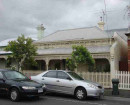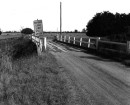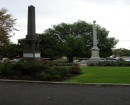BALLARAT REFORM LEAGUE CHARTER
PUBLIC RECORD OFFICE VICTORIA 99 SHIEL STREET NORTH MELBOURNE, MELBOURNE CITY
-
Add to tour
You must log in to do that.
-
Share
-
Shortlist place
You must log in to do that.
- Download report


Statement of Significance
What is significant?
The Ballarat Reform League Charter is a four-page handwritten manifesto of democratic principles and demands, presented to Governor Hotham in November 1854, a few weeks before the Eureka rebellion. The Charter is handwritten on watermarked government blue paper, folded into four foolscap-sized pages containing the text of the charter adopted by over 10,000 miners and storekeepers on Bakery Hill on the Ballarat goldfields on 11 November 1854, establishing its authority to represent the opinion of the majority of the adult population of Ballarat. The Southern Cross flag, designed and adopted by the Ballarat Reform League, was flown for the first time at this meeting. The Charter was presented to Governor Hotham on 27 November by representatives of this meeting, who also demanded the release of three prisoners arrested for burning a Ballarat hotel. This is a clerk's copy of the original Charter, held by the Public Records Office, Victoria. The original has not survived, and its format is unknown. The copy was created for administrative purposes by the Governor's office at the time it was received by Governor Hotham. It has markings on it indicating it was created by the Governor's office and that it was the copy read by Governor Hotham.
The Charter was transferred to the Archives Division of the State Library of Victoria in 1961 from the Office of the Governor of Victoria. It was part of a consignment of Governor's Inwards Correspondence. The Archives Division of the State Library of Victoria is the predecessor of Public Record Office Victoria, which came into existence as the independent Victorian state archive in 1973.
The Charter, written by members of the Ballarat Reform League and representing the aspirations and demands of the mining community of Ballarat, was instrumental in the campaigns for democratic reform in the Colony of Victoria. The Charter expresses universal democratic values, drawn from Chartist and other international democratic movements of its time. It asserted that the people are the only legitimate source of political power and demanded the abolition of the hated licence system, manhood suffrage, payment of members of parliament and no property qualification.
The Ballarat Reform League Charter is a manifesto that spelled out an agenda for political reform. Written by people who had been involved in democratic movements in their home countries, the Charter is a unique manifestation, in an Australian colonial context, of British Chartism and the ideas of European and North American democratic and liberal movements. The authors of the Charter drew on their experiences on the goldfields and on these ideals when formulating their solution to the pressing issues of goldfields reform. The Charter was a rallying point for the Ballarat miners, and storekeepers' assertion of their civil liberties, their need for greater participation in the political process in Victoria and their demands for changes to the administration of the goldfields. Significantly, the democratic reforms achieved in Victoria as a result of these campaigns occurred before reforms in other nation states around the world.
The Ballarat Reform League Charter is a central feature of the Eureka story, one of the most significant and influential events in Australia's political and social history. The events and people associated with the Eureka rebellion have been continuously commemorated and interpreted through Australian film, literature, television, radio, academic research, song, folklore, artworks, and in exhibitions and museums around Australia.
How is it significant?
Ballarat Reform League Charter is historically and socially significant to the State of Victoria.
Why is it significant?
Ballarat Reform League Charter is historically significant in the history of democracy in Victoria and as a central feature of the Eureka story, one of the most significant and influential events in Australia's political and social history. The Charter is also of historical significance as an expression of the Ballarat Reform League as a political movement and a forerunner of organised labour in Australia.
Ballarat Reform League Charter is socially significant as it is widely seen as having ongoing relevance to the Australian people and their democratic institutions. The struggle for democratic reform, as expressed in the Charter and the Eureka rebellion, is of fundamental significance to our understanding of Australian society and democratic institutions.
-
-
BALLARAT REFORM LEAGUE CHARTER - History
History of Object
The Ballarat Reform League Charter is of historical significance to the people of Australia as a powerful manifesto that spelled out an agenda for political reform. The Charter succeeded in summarising the will of thousands of men and women from many nations who had come to the colony of Victoria in search of prosperity. Written by people who had been involved in democratic movements in their home countries, the Charter is a unique manifestation, in an Australian colonial context, of British Chartism and the ideas of European and North American democratic and liberal movements. The authors of the Charter drew on their experiences on the goldfields and on these ideals when formulating their solution to the pressing issues of goldfields reform. The Charter was a rallying point for the Ballarat miners’ and storekeepers’ assertion of their civil liberties, their need for greater participation in the political process in Victoria and their demands for changes to the administration of the goldfields. Significantly, the democratic reforms achieved in Victoria as a result of these campaigns occurred before reforms in other nation states around the world.
The Charter spoke, and still speaks, simply and directly about profound things like freedom and democracy. The Charter was read out and its clauses agreed to by a ‘Monster Meeting’ of over 10,000 miners and storekeepers on the Ballarat goldfields on 11 November 1854, establishing its authority to represent the opinion of the majority of the adult population of Ballarat. The Southern Cross flag, designed and adopted by the Ballarat Reform League, was flown for the first time at this meeting. The Charter was presented to Governor Hotham on 27 November by representatives of this meeting, who also demanded the release of three prisoners arrested for burning a Ballarat hotel.
The Governor failed to respond to the delegation’s concerns so they returned to Ballarat and called another public meeting to continue the Reform League’s campaign. The miners feared and resented abuses of Government power as experienced by them at the hands of the Goldfields Commissioners, the police, and the judiciary. One of the responses to this turn of events was the emergence of what was to become the Eureka rebellion. Another response, pursued by the majority of the Ballarat Reform League, was the “moral force” approach which continued to seek a political and legislative solution.
In the following days the Eureka rebellion erupted at Ballarat, and was defeated. Shortly thereafter the treason trials of 13 of its participants, who were all found not guilty, provoked mass meetings around the colony in support of the stockaders and their demands for reform. The trials are highly significant in Australian judicial history, being the only treason trials to have taken place in Australia. The trials focussed public attention on the diggers’ involvement in Eureka including their campaign for democratic reform and the Charter. The failure of the treason trials gave heart to those who were interested in democratic reform. The Charter gained prominence at the time because it was recognised that the government had gone too far.
The Goldfields Royal Commission established by Governor Hotham on 16 November 1854 in response to the widespread unrest on the goldfields heard evidence from a range of interested parties including members of the Ballarat Reform League. In recognition of the significance of recent events and the groundswell of popular support for them, and acting on the recommendations of the Goldfields Royal Commission which presented its final report on 27 March, the Government enacted through the Parliament a range of measures that realised the bulk of the Reform League’s demands.
These changes went beyond the constitutional reforms that had been recommended by the Legislative Council as part of the formation of Victoria as a self-governing colony. These constitutional reforms, which included an extension of the franchise to miners who held an annual licence, had received Royal assent prior to the Eureka uprising. As a result of all of these measures the Colony of Victoria became the most democratic and representative legislatures in the world at the time. Other Australian colonial legislatures eventually adopted similar reforms, thereby laying the foundations for Australia’s enduring and robust tradition of democratic government and its egalitarian social ethos.
The Charter is also of historical significance as an expression of the Ballarat Reform League as a political movement and a forerunner of organised labour in Australia. The language of the Charter and the strategies used by the Reform League were vital in the development of political movements in Australia and were taken up by other organisations, such as the Land League. Thus, the Charter is a key document in Australia’s political history, being early evidence of an Australian tradition of political participation.
Bibliography
Bate, Weston, 1978, Lucky City, Melbourne University Press, Melbourne.
Beggs Sunter, Anne, 2002, The Birth of a Nation: Constructing and De-Constructing the Eureka Legend, unpublished PhD Thesis.
Carboni, Raffaello, 1993 (reprint), The Eureka Stockade [1855] Introduced by Tom Keneally, Melbourne University Press, Melbourne.
Curriculum Corporation, 2000, Discovering Democracy, Lower Secondary Units Assessment Resources, Curriculum Corporation, Melbourne.
Goodman, David, 1998, “Eureka Stockade” in Davison, G., Hirst, J. & Macintyre, S. (eds) The Oxford Companion to Australian History, Oxford University Press, Melbourne.
MacFarlane, Ian, 1995, Eureka From the Official Records, Public Record Office Victoria, Melbourne.
Molony, John, 2004, (unpub) “Eureka and the Prerogative of the People”, Address to the Australian Senate, 23 April 2004, Parliament House Canberra.
Molony, John, 2001, Eureka, Melbourne University Press, Melbourne.
Smith, James (ed), 1904, The Cyclopedia of Victoria (Illustrated), Vol. II, The Cyclopedia Company, Melbourne.
Serle, Geoffrey, 1968, The Golden Age: A History of the Colony of Victoria, 1851 – 1861, Melbourne University Press, Melbourne.
BALLARAT REFORM LEAGUE CHARTER - Permit Exemptions
General Exemptions:General exemptions apply to all places and objects included in the Victorian Heritage Register (VHR). General exemptions have been designed to allow everyday activities, maintenance and changes to your property, which don’t harm its cultural heritage significance, to proceed without the need to obtain approvals under the Heritage Act 2017.Places of worship: In some circumstances, you can alter a place of worship to accommodate religious practices without a permit, but you must notify the Executive Director of Heritage Victoria before you start the works or activities at least 20 business days before the works or activities are to commence.Subdivision/consolidation: Permit exemptions exist for some subdivisions and consolidations. If the subdivision or consolidation is in accordance with a planning permit granted under Part 4 of the Planning and Environment Act 1987 and the application for the planning permit was referred to the Executive Director of Heritage Victoria as a determining referral authority, a permit is not required.Specific exemptions may also apply to your registered place or object. If applicable, these are listed below. Specific exemptions are tailored to the conservation and management needs of an individual registered place or object and set out works and activities that are exempt from the requirements of a permit. Specific exemptions prevail if they conflict with general exemptions. Find out more about heritage permit exemptions here.Specific Exemptions:General Conditions: 1. All exempted alterations or repairs are to be planned and carried out in a manner which prevents damage to the fabric of the registered object. General Conditions: 2. Should it become apparent during further inspection or the carrying out of works that original or previously hidden or inaccessible details of the place or object are revealed which relate to the significance of the place or object, then the exemption covering such works shall cease and the Executive Director shall be notified as soon as possible. General Conditions: 3. If there is a conservation policy and plan approved by the Executive Director, all works shall be in accordance with it. General Conditions: 4. Nothing in this determination prevents the Executive Director from amending or rescinding all or any of the permit exemptions.STANDARD EXEMPTION : MOVEMENT OR RELOCATION
The temporary relocation, movement or external loan of a registered heritage object does not require permit approval by the Executive Director pursuant to the Heritage Act 1995 where the activity is performed in accordance with the accepted standards, policies and procedures of the Public Records Office Victoria. .
STANDARD EXEMPTION :CONSERVATION
The conservation, research or analysis of a registered heritage object does not require approval by the Executive Director pursuant to the Heritage Act 1995, where the activity is performed in accordance with the accepted standards, policies and procedures of the Public Records Office Victoria.
BALLARAT REFORM LEAGUE CHARTER - Permit Exemption Policy
The permit policy requires that the object be housed and conserved so as to maintain its cultural heritage significance. Exemptions will usually be granted for movement, relocation, loan and conservation activities, as specified below.
The original material is stored in a secure repository and appropriate climatic conditions. It can be viewed by appointment in the secure North Melbourne reading room of Public Record Office Victoria. The Charter is part of a series that is on open access, and is subject to the normal restrictions that apply: that original records can be viewed only in the secure North Melbourne reading room of the Public Record Office Victoria. Digital copies can be ordered for research, study and use in exhibition and reproduction.
-
-
-
-
-
BRASSEY HOUSE
 Victorian Heritage Register H0026
Victorian Heritage Register H0026 -
FORMER PRESBYTERIAN UNION MEMORIAL CHURCH COMPLEX
 Victorian Heritage Register H0007
Victorian Heritage Register H0007 -
RESIDENCE
 Victorian Heritage Register H0091
Victorian Heritage Register H0091
-
..esterville
 Yarra City
Yarra City -
1 Alfred Crescent
 Yarra City
Yarra City -
1 Barkly Street
 Yarra City
Yarra City
-
-
Notes See all notes
Ballarat Reform League Charter
17/11/14
Brilliant app! Any chance of linking through to http://amw.org.au/content/australian-register
Public contributions
Notes See all notes
Ballarat Reform League Charter
17/11/14
Brilliant app! Any chance of linking through to http://amw.org.au/content/australian-register












